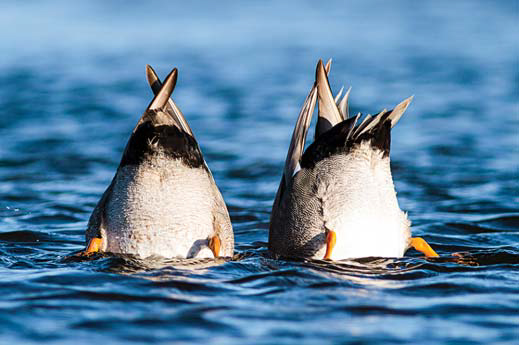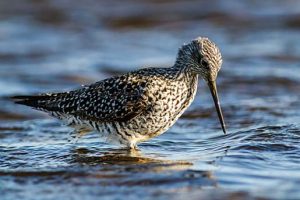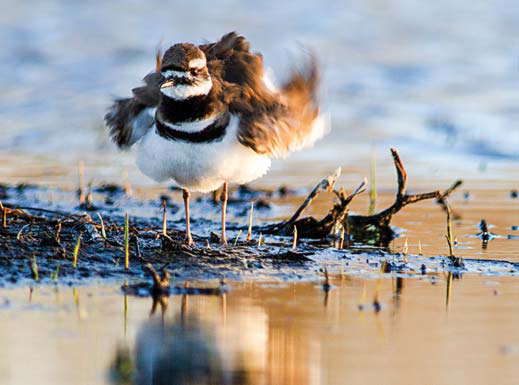
Story and photos by: Evan Barrientos
In late winter I would gaze longingly out my window at the clouds of migrating waterfowl whirling above the calm water.
I wanted to photograph this spectacle, but approaching the skittish birds through the open prairie seemed an impossible task. Then I met Michael Forsberg, famed Nebraska wildlife photographer.
I learned how Forsberg builds blinds out of garden fence and grass and sleeps in them, sometimes for days, in order to capture the most intimate moments of nature and share them with the rest of us.
I wanted to learn this art, too, so I headed to the hardware store to buy materials for my first blind and proceeded to make a very big mistake.

The store was out of garden fence so I bought chicken wire instead, thinking it couldn’t be too different. It could. I spent most of the next afternoon pounding stakes; cutting wire, camo cloth, and grass; and zip tying it all together in the rough shape of a burrito with a hole at one end and a window at the other.
The blind was placed right on the water’s edge and would have a spectacular view of ducks waking up in the golden light of sunrise. Or so I thought.
After leaving the blind out for two weeks to let the birds acclimate to it, I set out one March night with my camera gear and sleeping bag, crawled into the blind, and fell asleep to the quiet murmurs of roosting mallards. I was so eager for sunrise that I had no less than five dreams of waking up in the blind. In one dream I woke up underwater. In another I woke up to find the wetland dry.
When I finally did wake up, I discovered a snafu that I hadn’t even dreamt of: my blind had collapsed on me.
The chicken wire couldn’t support the added weight of the morning dew, and in order for me to see out the blind’s window I had to prop the darn thing up with my head. In addition to being extremely uncomfortable, I worried that the floppy blind would scare away the birds. Fortunately, it did not. Maybe the birds thought it was too pathetic to be man-made, or maybe it looked like a decomposing tree trunk, but they didn’t seem to notice me at all. I knew I was okay when a red-winged blackbird strolled across the top of my head.

What I sacrificed in comfort I made up for in views. It’s not often you get to see wild animals behave truly naturally, completely unaware of your presence.
Seeing a killdeer bathe in the golden light of sunrise, hearing blue-winged teal drakes whisper soft calls to a female, watching beads of water drip from a gadwall’s impermeable feathers – these were new and beautiful experiences for me. At one point, a great blue heron, normally too skittish to approach within 50 feet, spent 10 minutes hunting just a few feet away from me. I left the blind with some nice photographs and a very sore neck.
Pathetic as it was, I’m grateful to that blind for giving me glimpses into the lives of birds that I never would have had otherwise. It taught me a new way to appreciate wildlife, one that requires you to become a part of the landscape. Hunters and photographers know the value of extreme patience, but in today’s fast-paced society, rarely do we sit in a spot for hours and watch nature’s secrets reveal themselves. A blind, I learned, teaches you that patience and provides a window to a new view of nature. I hope to build many more blinds in the future, but never, ever again out of chicken wire. ■

By: Evan Barrientos
Evan is the monitoring and outreach assistant for the The Nature Conservancy in southwest Oregon. He has a passion for communicating ecological restoration and conservation through photography, videography, and blogging.Get your photos featured in an upcoming print edition of NEBRASKAland Magazine, on our website or social media!
That’s it! We’ll go through the entries monthly and notify you if your photo is selected.
The post Shooting Blinds appeared first on NEBRASKALand Magazine.






















